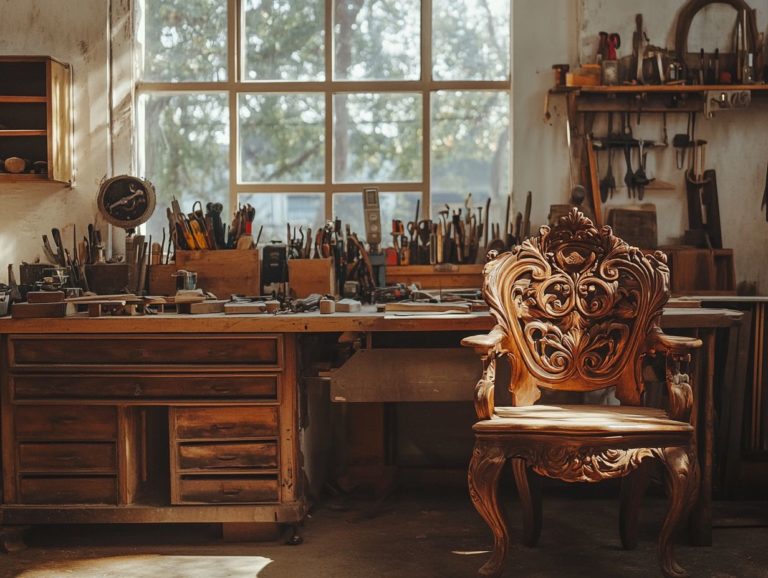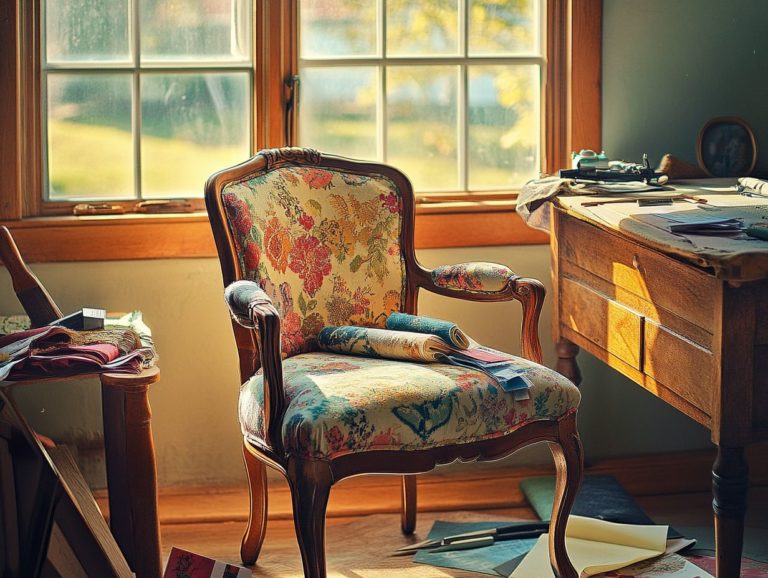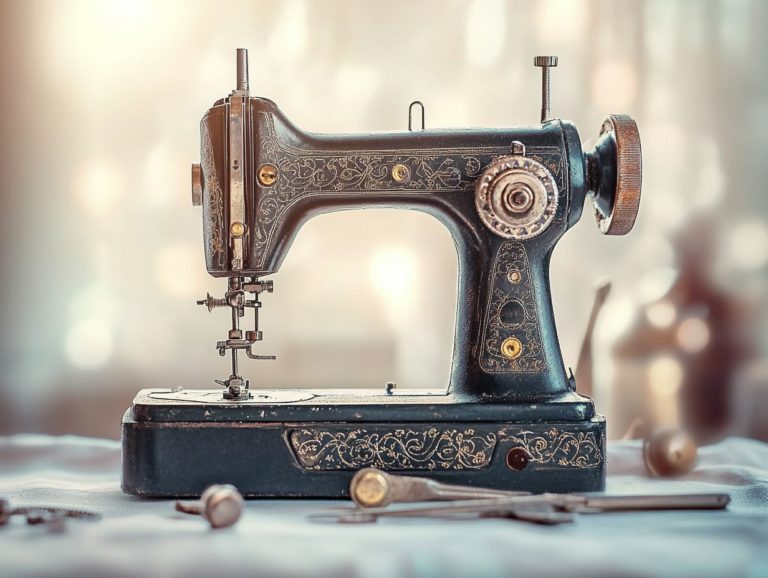How to Identify Valuable Vintage Furniture
Vintage furniture possesses a unique charm that can transform any space, and its value often goes far beyond mere aesthetics. Whether you re a seasoned collector or just beginning your journey, understanding what makes vintage pieces truly valuable is essential.
This article explores the defining traits of vintage furniture, covering everything from age and authenticity to quality and craftsmanship. You’ll learn how to identify valuable styles, spot quality indicators, and uncover the best places to find hidden gems. You will also find tips on caring for vintage furniture to help it last.
Prepare to elevate your understanding of vintage furniture to new heights!
Contents
- Key Takeaways:
- Factors that Determine Value
- Identifying Valuable Pieces
- Where to Find Vintage Furniture
- Caring for and Maintaining Vintage Furniture
- Frequently Asked Questions
- What is considered vintage furniture?
- How do I know if a piece is truly vintage?
- What should I look for when buying vintage furniture?
- How can I tell if a piece of furniture is valuable?
- What are some popular vintage furniture styles?
- Are there certain materials that make vintage furniture more valuable?
- Is it important to consider the condition of vintage furniture when determining its value?
- Are there any red flags to look out for when identifying valuable vintage furniture?
Key Takeaways:
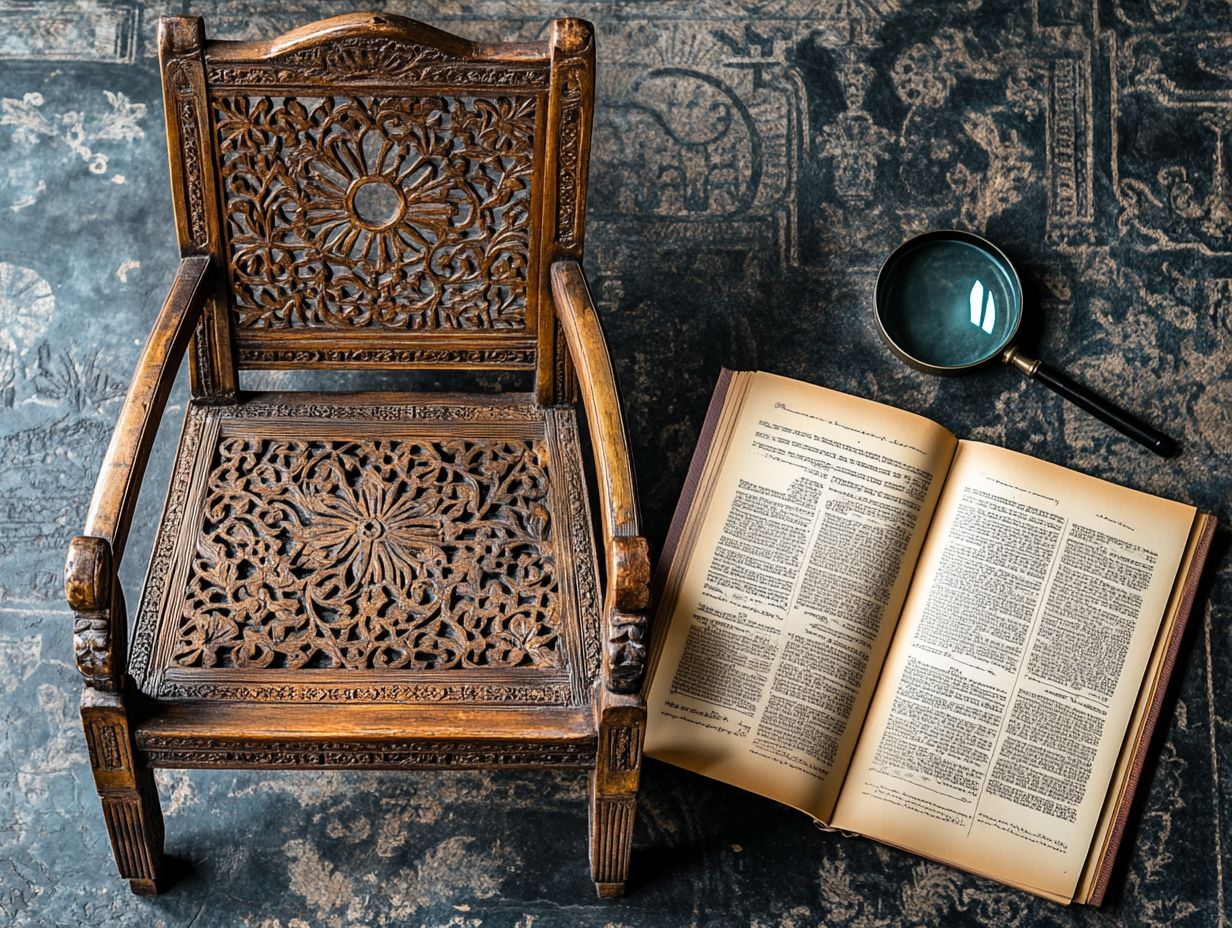
- Age and authenticity are key factors in determining the value of vintage furniture. Look for makers’ marks (a symbol indicating the maker), original features, and signs of age to identify valuable pieces.
- Quality and craftsmanship (the skill involved in making something) play a major role in the value of vintage furniture. Look for solid construction, quality materials, and attention to detail when evaluating a piece.
- To find valuable vintage furniture, search in places like antique shops, flea markets, estate sales, and online marketplaces. Be sure to thoroughly inspect the piece and negotiate for a fair price.
Defining Vintage Furniture
Vintage furniture captures a unique blend of age and craftsmanship, often showcasing styles from various historical periods such as Victorian and Colonial.
These timeless pieces offer you a window into the artistry of bygone eras, featuring intricate details and materials that have largely fallen out of fashion. The allure of vintage furniture lies not only in its aesthetic charm but also in the rich history embedded within each piece.
Typically crafted from solid woods like mahogany, walnut, oak, and cherry, vintage items stand in stark contrast to the engineered materials often used in today’s contemporary designs. To recognize vintage furniture, pay attention to its construction techniques. Dovetail joints (a type of joint that interlocks wood pieces) and hand-carved elements serve as hallmarks of authenticity, distinguishing them from modern mass-produced alternatives. For more insights, check out our guide on how to spot quality vintage furniture.
By appreciating these characteristics, you can truly understand how vintage furniture enhances a space, enriching it not just with style but also with a compelling narrative.
Factors that Determine Value
When assessing the value of vintage furniture, several key factors come into play: age, authenticity, quality, and craftsmanship. Each of these elements significantly contributes to the overall value of the piece and its status as an antique.
Understanding these intricacies is essential for anyone involved in furniture appraisal, whether you’re curating a personal collection or preparing for resale.
Age and Authenticity
One of the key factors that determines the value of vintage furniture is its age, which often signifies authenticity and antique characteristics. When you come across pieces from specific eras, like the Civil War era or Victorian times, their authenticity becomes even more apparent when assessed through proper furniture inspection methods.
Understanding the age of a piece provides valuable insights into its craftsmanship and the materials used, which directly influences its appeal to collectors and enthusiasts alike. Experts in the field advocate for the use of specialized tools and techniques for verification, such as examining joints, finishes, and any maker’s marks (symbols indicating the maker). These details not only confirm the authenticity of the furniture but also enhance its provenance (the history of ownership), ultimately boosting its market value.
For anyone looking to invest in vintage pieces, grasping the nuances of age and authenticity is crucial for making informed decisions. Ready to uncover the secrets of vintage furniture? Let’s dive in!
Quality and Craftsmanship
The quality and craftsmanship of vintage furniture play a crucial role in determining its value. Intricate details, unique features, and superior construction techniques often signal higher worth, especially in the eyes of antique dealers. Look for elements like dovetail joints and meticulous craftsmanship, as these can serve as key indicators of a piece’s quality.
For instance, a dining table with hand-cut dovetail joints and a hand-rubbed finish not only highlights the artistry behind its creation but also enhances its longevity. Solid hardwood construction speaks to durability, while strong wood joints reflect a commitment to timeless quality.
These features give character and appeal to collectors who seek authenticity. Choosing wood species like walnut or mahogany elevates desirability, as these materials are not only visually stunning but also incredibly resilient.
Thus, when you assess vintage items, it becomes clear that these aspects of quality and craftsmanship significantly influence their market value.
Identifying Valuable Pieces

Spotting valuable vintage furniture can be an exciting challenge! It demands a discerning eye for details like furniture markings, historical significance, and overall aesthetics. This skill in furniture identification is essential for collectors and enthusiasts alike.
Engaging an expert s opinion can significantly enhance your ability to assess unique pieces accurately, ensuring you appreciate the true value of your finds.
Popular Vintage Furniture Styles
Popular vintage furniture styles encompass iconic designs from various historical eras, including:
- Victorian
- Colonial
- Queen Anne
Each of these styles offers distinctive aesthetics and craftsmanship that you ll want to appreciate fully. Understanding them is essential, especially if you re a collector eager to delve into the rich history of furniture associated with each period.
Take, for example, Victorian furniture, which dazzles with elaborate ornamentation and intricate woodwork, reflecting the grandeur from the Industrial Revolution. In contrast, Colonial styles exude simplicity and practicality, showcasing the influences of early American life. Then there s the Queen Anne style, which captivates with its elegant curves and cabriole legs, epitomizing refined craftsmanship from the early 18th century.
As a collector, you ll find joy in identifying key elements like the materials such as mahogany or walnut and the specific techniques employed. This exploration creates a deeper connection to the past and the fascinating stories that each piece carries.
Signs of Quality and Authenticity
Recognizing signs of quality and authenticity is crucial for anyone with an interest in vintage furniture. Look for specific antique characteristics, such as furniture markings, construction methods, and the materials used. A thorough inspection of each piece can unveil its true value and rich history.
As you inspect, pay close attention to key elements such as dovetail joints a hallmark of careful craftsmanship typically found in authentic pieces. Examine the finish; original stains and paints often exhibit a depth and richness that modern reproductions simply can’t replicate.
Look for labels or stamps, as these marks can provide insights into the item’s provenance. The wear patterns and patina tell stories of its age and usage over time. By mastering these details, you can effortlessly distinguish genuine vintage treasures from mere mass-produced replicas.
Where to Find Vintage Furniture
Embarking on the quest for vintage furniture can be an exhilarating journey, filled with enticing avenues to explore. From charming secondhand stores and lively household auctions to quaint garage sales and specialized antique shops, each location holds the promise of uncovering hidden treasures.
Knowing where to look can significantly boost your chances of finding invaluable pieces that add character to your space.
Places to Search for Valuable Pieces
To effectively search for valuable pieces of vintage furniture, you should explore a variety of venues, including antique dealers, auctions, and garage sales. Each of these locations presents unique opportunities to uncover rare finds that can enhance your collection.
Antique dealers often showcase well-preserved items, such as Victorian chairs and mid-century modern tables. These pieces reflect the craftsmanship of different eras.
Auctions can surprise you with unexpected treasures like unique sideboards or vintage d cor. However, they may require a keen eye and sometimes a willingness to engage in bidding wars.
Garage sales frequently offer the most casual yet fruitful encounters. With a bit of patience, you could uncover amazing finds like a rustic farmhouse table or an old trunk filled with history.
Always bring along a measuring tape and a camera. Documenting pieces of interest will help you make informed decisions later, ensuring that each addition to your collection is a true gem.
How to Spot a Good Deal
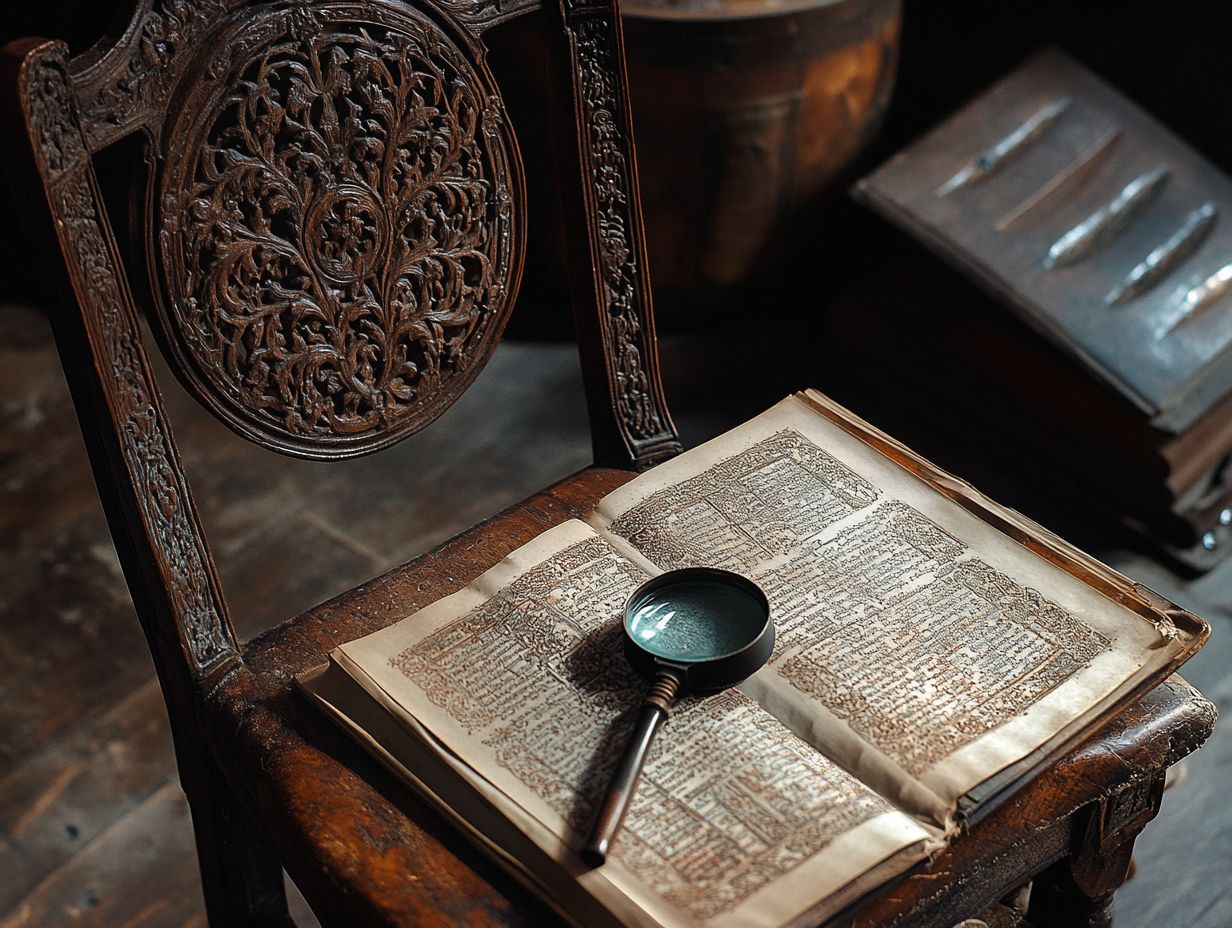
Spotting a good deal on vintage furniture requires good knowledge of prices and fair market value. This knowledge enables you to determine whether a piece is priced competitively.
To effectively navigate this niche market, begin by researching similar items online. Platforms like eBay or Chairish can provide a clear picture of current sale prices, helping you gauge value.
Don’t overlook the potential treasures waiting to be discovered at estate sales, auctions, and flea markets. Vintage pieces are often available at lower costs.
Engaging with local vintage shops and online communities dedicated to furniture enthusiasts can offer you invaluable insights into authentic vintage styles and trends. Recognizing the importance of condition, the history of ownership, and brand will give you the power to identify true quality pieces.
This knowledge enhances your appreciation of vintage furniture and ensures your investment is sound.
Caring for and Maintaining Vintage Furniture
Caring for and maintaining vintage furniture is crucial for preserving its value and integrity. You should prioritize proper cleaning techniques and commit to regular maintenance to prevent any deterioration.
It’s also essential to understand the risks involved in restoration. This knowledge will help ensure that your treasured pieces remain in excellent condition for years to come.
Proper Cleaning and Preservation Techniques
Proper cleaning and preservation techniques are crucial for maintaining the beauty and longevity of your vintage furniture. It requires a gentle touch, carefully considering specific materials and finishes.
By implementing effective furniture conservation methods, you can significantly enhance the lifespan of these cherished pieces.
Understanding the unique characteristics of wood, leather, and fabric gives you the power to select the appropriate cleaning agents and preservation techniques. This ensures you avoid damaging those delicate surfaces.
For example, using a soft, lint-free cloth paired with a specialized wood cleaner will protect the finish on your wooden antiques. Similarly, applying specific leather creams nourishes vintage leather upholstery and helps prevent cracking.
Maintaining proper humidity levels and steering clear of direct sunlight are essential steps to guard against warping and fading. When you apply these knowledgeable techniques, your vintage furniture will not only retain its aesthetic appeal but will also narrate a rich history, adding depth and charm to any living space.
Frequently Asked Questions
What is considered vintage furniture?
Vintage furniture refers to pieces that are at least 20 years old and have some level of historical or aesthetic value.
How do I know if a piece is truly vintage?
To determine if a piece is truly vintage, check its age, style, materials, and any identifying marks, such as labels or stamps.
What should I look for when buying vintage furniture?
Look for quality craftsmanship, unique design elements, and the overall condition of the piece. Make sure it aligns with your personal style and needs.
Start caring for your vintage furniture today to ensure it stays beautiful for years to come!
How can I tell if a piece of furniture is valuable?

You can identify valuable vintage furniture in a few ways. Look for designer or manufacturer labels, quality materials, and research the piece’s history.
What are some popular vintage furniture styles?
Popular vintage furniture styles include mid-century modern, art deco, and Victorian. Each style has its own look, and they can also vary in value.
Are there certain materials that make vintage furniture more valuable?
Absolutely! Solid wood, premium fabrics, and original hardware can really boost a piece’s value.
Is it important to consider the condition of vintage furniture when determining its value?
The condition of vintage furniture greatly affects its value. Pieces in good condition typically hold more value than those with damage or alterations.
Are there any red flags to look out for when identifying valuable vintage furniture?
Yes, be cautious of pieces that have been heavily refinished or restored. Also, watch for missing original parts and reproductions sold as authentic vintage pieces.

